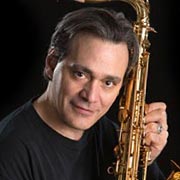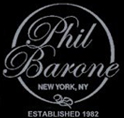Oct 13

Saxophone-A History
by Phil Barone
Saxophone History and Materials
The saxophone (also referred to as the sax) is a family of woodwind instruments. Saxophones are usually made of brass and played with a single-reed mouthpiece similar to that of the clarinet. Like the clarinet, saxophones have holes in the instrument which the player closes using a system of key mechanisms. When the player presses a key, a pad either covers a hole or lifts off a hole, lowering or raising the pitch, respectively.
The saxophone family was invented by the Belgian instrument maker Adolphe Sax in 1840. Adolphe Sax wanted to create a group or series of instruments that would be the most powerful and vocal of the woodwinds, and the most adaptive of the brass instruments, that would fill the vacant middle ground between the two sections. Mr. Sax patented the saxophone on June 28, 1846, in two groups of seven instruments each. Each series consisted of instruments of various sizes in alternating transposition. The series pitched in B♭ and E♭, designed for military bands, have proved popular and most saxophones encountered today are from this series. Instruments from the so-called "orchestral" series, pitched in C and F, never gained a foothold, and the B♭ and E♭ instruments have now replaced the C and F instruments when the saxophone is used in an orchestra.
The saxophone is used in classical music (such as concert bands, chamber music, solo repertoire, and, occasionally, orchestras), military bands, marching bands, and jazz (such as big bands and jazz combos). The saxophone is also used as a soloing and melody instrument or as a member of a horn section in some styles of rock and roll and popular music. Saxophone players are called saxophonists.
The saxophone was developed in 1846 by Adolphe Sax, a Belgian instrument maker, flautist, and clarinetist. Born in Dinant and originally based in Brussels, he moved to Paris in 1842 to establish his musical instrument business. Prior to his work on the saxophone, he had made several improvements to the bass clarinet by improving its keywork and acoustics and extending its lower range. Sax was also a maker of the then-popular ophicleide, a large conical brass instrument in the bass register with keys similar to a woodwind instrument. His experience with these two instruments allowed him to develop the skills and technologies needed to make the first saxophones. As an outgrowth of his work improving the bass clarinet, Sax began developing an instrument with the projection of a brass instrument and the agility of a woodwind. He wanted it to overblow at the octave, unlike the clarinet, which rises in pitch by a twelfth when overblown. An instrument that overblows at the octave has identical fingering for both registers.
Sax created an instrument with a single-reed mouthpiece like a clarinet, conical brass body like an ophicleide, and some acoustic properties of both the horn and the clarinet.
Having constructed saxophones in several sizes in the early 1840s, Sax applied for, and received, a 15-year patent for the instrument on June 28, 1846. The patent encompassed 14 versions of the fundamental design, split into two categories of seven instruments each, and ranging from sopranino to contrabass. Although the instruments transposed at either F or C have been considered "orchestral", there is no evidence that Sax intended this. As only three percent of Sax's surviving production were pitched in F and C, and as contemporary composers used the E♭ alto and B♭ bass saxophone freely in orchestral music, it is almost certain that Sax experimented to find the most suitable keys for these instruments, settling upon instruments alternating between E♭ and B♭ rather than those pitched in F or C, for reasons of tone and economy (the saxophones were the most expensive wind instruments of their day). The C soprano saxophone was the only instrument to sound at concert pitch. All the instruments were given an initial written range from the B below the treble staff to the F, one space above the three ledger lines above staff, giving each saxophone a range of two and a half octaves.
Sax's patent expired in 1866; thereafter, numerous saxophonists and instrument manufacturers implemented their own improvements to the design and keywork. The first substantial modification was by a French manufacturer who extended the bell slightly and added an extra key to extend the range downwards by one semitone to B♭. It is suspected that Sax himself may have attempted this modification. This extension is now commonplace in almost all modern designs, along with other minor changes such as added keys for alternate fingerings. Using alternate fingerings allows a player to play faster and more easily. A player may also use alternate fingerings to bend the pitch. Some of the alternate fingerings are good for trilling, scales, and big interval jumps.[6]
Sax's original keywork, which was based on the Triebert system 3 oboe for the left hand and the Boehm clarinet for the right, was simplistic and made playing some legato passages and wide intervals extremely difficult to finger, so numerous developers added extra keys and alternate fingerings to make chromatic playing less difficult. While early saxophones had two separate octave vents to assist in the playing of the upper registers just as modern instruments do, players of Sax's original design had to operate these via two separate octave keys operated by the left thumb. A substantial advancement in saxophone keywork was the development of a method by which the left thumb operates both tone holes with a single octave key, which is now universal on modern saxophones. Further developments were made by Selmer in the 1930s and '40s, including offsetting tone holes and a revamping of the octave key mechanism, beginning with balanced action instruments and continuing through their celebrated Mark VI line. One of the most radical, however temporary, revisions of saxophone keywork was made in the 1950s by M. Houvenaghel of Paris, who completely redeveloped the mechanics of the system to allow a number of notes (C♯, B, A, G, F and E♭) to be flattened by a semitone simply by pressing the right middle finger. This enables a chromatic scale to be played over two octaves simply by playing the diatonic scale combined with alternately raising and lowering this one digit.[7] However, this keywork never gained much popularity, and is no longer in use.
Description
The saxophone consists of an approximately conical tube, usually of thin brass, flared at the tip to form a bell. At intervals along the tube are between 20 and 23 tone holes of varying size and two very small vent holes to assist the playing of the upper register. These holes are covered by keys (also known as pad cups) containing soft leather pads, which are closed to produce an airtight seal. At rest some of the holes stand open and others are closed. The keys are activated by keytouches pressed by the fingers, either directly on the pad cup or connected to it with levers, either directly or with joints called "linkages." The right thumb sits under a thumb rest to stabilize and balance the saxophone, while the weight of most saxophones is supported by a neckstrap attached to a strap ring on the rear of the body of the instrument. The fingering for the saxophone is a combination of that of the oboe with the Boehm system and is very similar to the flute or upper register of the clarinet. Instruments that play to low A have a left thumb key for that note.
The simplest design of saxophone is a straight conical tube, and the sopranino and soprano saxophones are usually of this design. However, as the lower-pitched instruments would be unacceptably long, they usually incorporate a U-bend ("bow") at or slightly above the third-lowest tone hole. As this would cause the bell to point almost directly upward, the end of the instrument is either beveled or tilted slightly forward. This U-shape has become a distinctive feature of the saxophone family, to the extent that soprano and even sopranino saxes are sometimes made in the curved style. By contrast, tenors and even baritones have occasionally been made in the straight style.[8][9] Most commonly, however, the alto and tenor saxophones incorporate a detachable, curved "neck" above the highest tone hole directing the mouthpiece to the player's mouth while the instrument is held in a playing stance. The baritone, bass, and contrabass saxophones accommodate the length of the bore with extra bows and right-angle bends between the main body and the mouthpiece.
Materials
Most saxophones, past and present, are made from brass. Despite this, they are categorized as woodwind instruments rather than brass, as the sound waves are produced by an oscillating wooden reed, not the lips against a mouthpiece as in a brass instrument, and because pitches are produced by breath wind passing opening and closing keys. The screw pins that connect the rods to the posts, as well as the needle and leaf springs that cause the keys to return to their rest position after being released, are generally made of blued or stainless steel. Since 1920, most saxophones have "key touches" (smooth replaceable pieces placed where the fingers touch the instrument) made from either plastic or mother of pearl. Recently, some saxophones are offered with abalone or stone keytouches.
Other materials have been tried with varying degrees of success, such as the 1950s Grafton plastic alto saxophone and its recent successor, the polycarbonate saxophone, Vibratosax. There is also the wooden Sawat saxophone created in Thailand on a small scale. Recent years have seen the use of higher copper alloys substituted for the "yellow brass" or "cartridge brass" that are most common, for visual and tonal effect. Yanagisawa's 902 and 992 series saxophones are made with phosphor bronze, which is claimed to offer slightly different, more "vintage" tonal qualities from the brass 901 and 991 models of identical design.[10] Other saxophones made of high copper alloys are sold under the brands Chateau, Kessler, Saxgourmet, and Bauhaus Walstein. Yanagisawa and other manufacturers, starting with the King Super 20 around 1950, have made saxophone necks, bells, or entire instruments from sterling silver.[11] Keilwerth and P. Mauriat have made saxes with a nickel silver body.[12][13] Opinions vary on the significance of body materials to sound. With the exception of the identical brass and phosphor bronze Yanagisawa models, opportunities to isolate body materials from other variables in design and construction are lacking.
Prior to final assembly of the saxophone, the manufacturers usually apply a thin coating of clear or colored acrylic lacquer or silver plate over the brass. The lacquer or plating serves to protect the brass from oxidation and maintains its shiny appearance. Several different types and colors of surface finish have been used over the years. It is also possible to plate the instrument with nickel or gold, and a number of gold-plated saxophones have been produced. Plating saxophones with gold is an expensive process because gold does not adhere directly to brass. As a result, the brass is first plated with silver, then gold. Some saxophonists, sellers, and repair technicians argue that the type of lacquer or plating or absence thereof may enhance an instrument's tone quality. The possible effects of different finishes on tone are difficult to isolate from the other variables that affect an instrument's tone colors although experiments have been done have been done discounting this. In any case, what constitutes a pleasing tone is a matter of personal preference.


